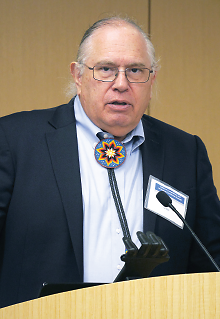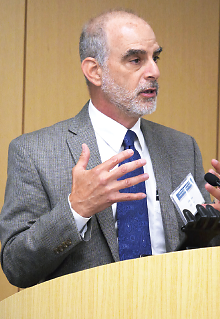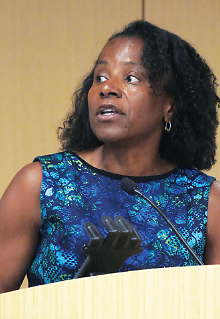Implementing Cultural Competence Means Inclusion Plus Measurement
Abstract
Making diversity really work takes special efforts throughout an organization.
Cultural competence—whether in health care, academia, or business—should mean more than encouraging more people of different racial or cultural backgrounds to be part of an organization, according to speakers at a conference in Washington, D.C., in June.

Changes in policies, values, structures, and standards will help build real cultural competence, said Terry Cross, M.S.W.
The goal is not simply the achievement of diversity but inclusion, said opening speaker Terry Cross, M.S.W., of the National Indian Child Welfare Association.
“Cultural competence means being able to function in the context of cultural differences,” said Cross. “Inclusion is not just having people show up at the door but about their being able to be who they are.”
The conference was cosponsored by APA, Ohio State University, and General Motors.
Yet how can an organization know where it stands and how well it has progressed toward achieving cultural competence and inclusion?
“You can’t manage what you can’t measure,” said Joshua Schwarz, Ph.D., a retired professor of management at Miami University, Ohio, recalling an adage in the field.
Most attempts to measure cultural competence have been ad hoc, limited to specific occupational categories, poorly validated, or not freely available, said Schwarz.
In response, he and his colleagues developed the Healthcare Provider Cultural Competence Instrument, which incorporates both a general awareness/sensitivity dimension and a more conventional multicultural approach to measurement. It also has cross-occupation validity, a better approach than developing individual training programs for smaller professional populations, he said.
“Have patience,” added Sonja Harris-Haywood, M.D., M.S., senior associate dean in the College of Medicine at the Northeast Ohio Medical University in Cleveland. “Cultural competence assessment and measurement is a journey.”
Harris-Haywood helped develop a set of 67 questions to measure knowledge of cultural competence and its implementation, as well as community engagement.

Measures to gauge cultural competence should apply across all the health professions, said Joshua Schwarz, Ph.D.
In medicine, said Schwarz, “the most important aspect of cultural competence is the attitude of practitioners toward patients, particularly patients from different cultures.”
At a minimum, clinicians must be aware of how their own biases influence patients’ experience of the health care encounter, he said. Clinicians must learn the skills needed to draw from patients their own perspectives on illness so they can take part in informed decision making.
Inclusion is difficult today less because of major, blatant forms of discrimination than of less obvious exclusion, said Ranna Parekh, M.D., M.P.H., director of APA’s Division of Diversity and Health Equity.
Parekh noted that Harvard psychiatrist Chester Pierce, M.D., coined the term “microagressions” in 1970 to describe not the major indignities of traditional racism but the “subtle, stunning, often automatic, and nonverbal exchanges” that implicitly degrade members of minority groups and provide advantage to members of the dominant culture. The tension and stress induced by microaggressions can affect physical and mental health as well as job prospects, said Parekh.
Measuring the subtleties of inclusion is more difficult than simply counting heads, noted several speakers.
“Metrics are indispensable to transforming organizations into learning organizations,” said Douglas Haynes, Ph.D., a professor of history and vice provost for academic equity, diversity, and inclusion at the University of California, Irvine (UCI).
“For too long, we didn’t measure diversity and inclusion,” he said. “We have to recognize the uneven landscape of opportunity.”
Universities typically focus on getting new students or faculty from diverse cultural backgrounds into their institutions and helping them adjust. To go beyond that, UCI more recently has required all applicants for faculty positions to provide a diversity statement—but doesn’t specify what is to be included and so permits an open-ended response.
Surveys of faculty attitudes at UCI find high stated support for diversity, inclusion, and equity but also significant levels of microaggressions and bias in personal interactions, said Haynes. “We need to come up with some type of training tool associated with assessment so we can feed that back to equip the faculty to be more self-aware.”
The result would enable people at UCI to “maximize their potential for growth and achievement and increase the capacity of the university to be responsive to the grand challenges of society and the world.”

Sonja Harris-Haywood, M.D., M.S., measured and validated knowledge and implementation of cultural competence.
Within the medical professions, one way of achieving greater goals is by breaking down professional silos, said Robert Like, M.D., M.S., a professor and director of the Center for Healthy Families and Cultural Diversity at the Rutgers Robert Wood Johnson Medical School in New Brunswick, New Jersey.
“We need more co-teaching and more co-learning to understand both our own and others’ perspectives,” he said. “How do we teach what is universal as well as what is individual?”
Hot-button issues that bring out people’s emotions may create problems in the open, but Like warned that “cold-button” issues may cause people to shut down and not communicate, thus blocking resolution of conflicts.
Attitudinal change is slower than behavioral change, said Parekh. However, consciousness of microaggressions can lead to “microaffirmations”—subtle, small acknowledgments of a person’s value and accomplishments—that can affect both personal interactions and institutional behavior.
Finally, said Bruce Steward, former acting director of the Office of Diversity and Inclusion in the U.S. Office of Personnel Management, it may be time for a “New IQ”—an “inclusion quotient.”
“The old IQ was about how smart you are as an individual,” said Steward. “The new IQ is about how smart you make your team. We know that the more diversity you have on your team, if managed in an inclusive way, it makes for a smarter team.”
Maintaining that diversity means developing practices that become habitual, said Steward, who identified five habits that reinforce inclusion. Fairness is the biggest challenge, he said. However, openness, cooperation, support (especially for work-life balance and for diversity and inclusion), and empowerment all contribute to upholding diversity. ■
More information about APA and diversity issues can be found in the article “Diversity Mental Health Month: Cultural Competency Key to Better Outcomes” here.



